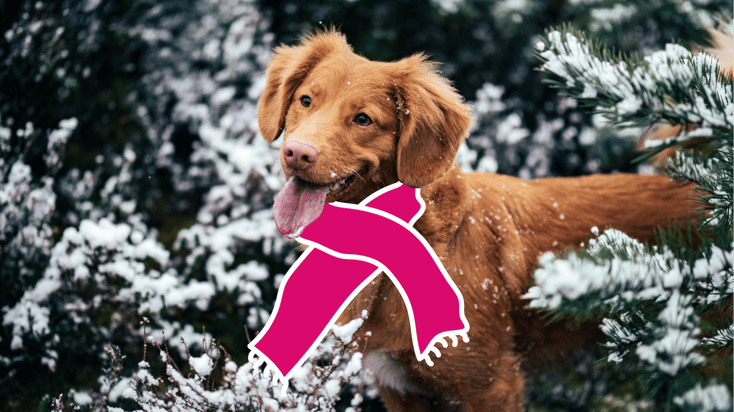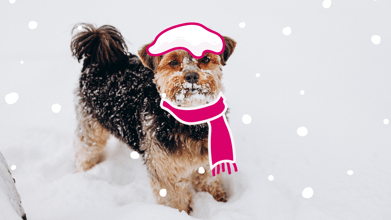Top Winter Care Tips for Dogs

Your pups may love playing in the snow, but winter weather can be harsh on their furry selves. It takes extra care and precautions to keep dogs safe and healthy in the wintertime.
Dogs may be impacted by cold weather and winter conditions, even if they aren't showing obvious symptoms, so it's very important to take a proactive approach to their care. That means knowing the signs and symptoms of cold-related problems, knowing how to keep your dog warm and comfortable, and understanding what to do if anything goes wrong.
In this post I'll cover the best winter care tips for dogs including winter dog grooming, diet and exercise adjustments, recognizing and preventing frostbite in dogs, and everything else you'll need to keep your furry friends safe and warm this winter.
Keeping Your Dog Warm: Coat and Paw Protection
Even though dogs have thick fur coats, they can still experience weather-related symptoms, so it’s important to be cautious when spending extended periods outdoors.
If you’re not sure if it’s too cold to walk your dog outside, consider keeping them entertained inside instead. As a general rule, if it feels too cold for you to be comfortable, it’s too cold for your dog, too!
Regular walks can also cause issues if sidewalks are treated with salt, which can cause dryness, cracking, and irritation for gentle paws.
Some dogs, especially short-haired breeds, can benefit from winter wear for paw protection and heat preservation, including:
- Sweaters and dog coats
- Well-fitted booties to keep their paws warm and protected from frostbite
- Pet-safe heated beds to stay cozy indoors
- Extra blankets or raised beds to keep your pup away from cold floors
Protecting Dog Paws and Skin
Dogs' extremities are susceptible to all kinds of issues in winter, ranging from mild to severe. Paws and skin can dry out, crack, or get irritated due to weather. In more serious cases dogs can even get frostbite.
Make sure to dry your dog thoroughly after any baths, especially if they'll be spending any time outside. If they do go outside, limit the time they spend outdoors, especially in snow, and if possible keep their paws protected with booties.
Your dog's fur also thickens in winter to protect them from the elements, so they may need extra grooming to keep their coat healthy. Make sure to brush your dog's fur every day in winter to prevent matting.
Diet and Exercise Adjustments
Typically dogs will expend less energy in winter due to lower activity, so to reduce the risk of weight gain it is usually recommended to maintain or sometimes even reduce their calorie intake.
You may want to add a supplement to make sure that your dog is getting adequate nutrients. Before making any changes to your pup’s diet, I recommend consulting with your veterinarian first. I also suggest that your dog has extra water available, as they can become dehydrated in indoor, heated conditions.
Keeping your dog active and mobile keeps their joints nimble and their body healthy, which can help older dogs with arthritis and younger dogs with boredom and muscle maintenance.
Indoor exercise options for dogs can include:
- Playing hide and seek
- Tug of war
- Playing fetch on non-slip floors
- Creating indoor obstacle courses with furniture or household objects
- Interactive puzzles
- Using indoor dog parks or toys
Dog Cold Weather Hazards: Recognizing and Preventing Winter Hazards
All your dog's extremities are susceptible to frostbite in winter. Monitor their paws, ears, and tails for signs of cold or red skin.
Signs of frostbite in dogs can include:
- Pale, gray, or red skin or paws
- Cold or hard skin or paws
Spending too much time outside in wintertime can also lead to hypothermia in dogs. If your dog is spending time outdoors in cold weather keep a close eye out for these symptoms:
- Shivering
- Cold extremities like ears, paws, and tails
- Lethargy and muscle weakness
- Slowness of movement
While shivering and cold extremities is a normal reaction to the cold, signs of lethargy, shivering that does not subside after going inside, or loss of consciousness are all reasons to seek immediate emergency care for your dog.
Indoor Hazards
Common holiday household items can be very toxic for dogs. These include the hand warmers that keep our own gloves and mittens warm, holiday ornaments, which could be chewed or swallowed, and certain shipping/packing materials.
Supervise your dog at all times around open flames (candles and wood-burning fireplaces) as well as holiday lights and Christmas trees, which present electrical and fire hazards if broken or knocked over.
Another winter hazard to be aware of is antifreeze. Dogs love the taste and it is extremely toxic, even deadly, if consumed. Always store antifreeze out of reach of your pup.
Certain holiday and winter plants are also highly toxic if eaten by your dog, so make sure they stay out reach of your furry friend. These include amaryllis, holly, and mistletoe.
Senior Dog Winter Care and Other Special Considerations
Senior dogs require special care during the winter season due to their aging joints. If your dog has arthritis, the cold weather can cause additional discomfort and aching joints.
Short-haired breeds are also more susceptible to cold because they lack the protective layer of fur that other pups have. I suggest putting a good winter coat on short-hair breeds if you take them outdoors, but make sure not to let them stay out for too long.
Both senior and short-hair dogs require extra steps to keep them warm during the winter months. Add extra blankets to bedding, protect gentle paws with booties, limit outdoor time, and monitor carefully for signs of chilliness, frostbite, and hypothermia.
Is Your Dog Showing Signs of Osteoarthritis Pain?
1. Limps after exercise or active play.
2. Has trouble keeping up on walks.
3. Is slow to get up from sitting or lying down.
4. Has difficulty jumping up and down.
5. Seems stiff when moving around.
6. Has difficulty climbing up and going down the stairs.
7. Changes in appetite - your dog is showing less interest in food.
8. Changes in grooming - your dog is not grooming as much or is licking certain areas more than usual.
9. Personality changes - your dog is less sociable than usual or is resistant to being touched.
10. Changes in potty habits - your dog is having accidents inside the house or does not want to go outside.
View Results
Is Your Dog Showing Signs of Osteoarthritis Pain?
1. Limps after exercise or active play.
2. Has trouble keeping up on walks.
3. Is slow to get up from sitting or lying down.
4. Has difficulty jumping up and down.
5. Seems stiff when moving around.
6. Has difficulty climbing up and going down the stairs.
7. Changes in appetite - your dog is showing less interest in food.
8. Changes in grooming - your dog is not grooming as much or is licking certain areas more than usual.
9. Personality changes - your dog is less sociable than usual or is resistant to being touched.
10. Changes in potty habits - your dog is having accidents inside the house or does not want to go outside.
Share Quiz
Emergency Preparedness: Emergency Dog Care in Winter
If your dog is exhibiting signs of frostbite or hypothermia, move them to a warm space immediately to help raise their body temperature. Wrapping your dog in a warm blanket or warming them with a warm water bottle can help to stabilize their temperature while on your way to emergency care.
If your dog is experiencing symptoms of frostbite or hypothermia, an emergency veterinary visit is a necessity. I recommend urgent care as soon as possible to prevent lasting damage.
Conclusion
If you have any concerns about your dog's health during the winter, make sure to consult with a qualified veterinarian for advice on how to best care for your pup in the cold.
Schedule a dog health checkup today to make sure your furry friends stay safe and healthy this winter!
Get Your Pet’s Health Checked Out at Home
Say goodbye to stressful vet visits and hello to a comfortable wellness exam in your pet's favorite spot.
Frequently Asked Questions
How can I tell if my dog is too cold during winter walks?
If you’re cold, your dog is probably cold too! Signs of discomfort from cold weather in dogs include shivering, weakness, lethargy, and red, flaky, or irritated skin.
What are the best types of dog coats for winter?
The best dog coats for winter vary by size, but a standard dog sweater or coat will work for most dogs. For short-haired pups, senior dogs, or severe weather conditions, a thick fleece coat or puffer jacket should insulate them from the cold. Make sure the sweater or coat allows for full mobility of their arms and legs and is not too tight around their neck and chest.
How can I keep my dog active indoors during winter?
To keep your dog active and happy indoors, try the following winter activities for dogs: playing hide and seek, tug of war, playing fetch, creating obstacle courses, interactive puzzles or using indoor dog parks and toys.
Is it necessary to change my dog’s diet in winter?
Typically dogs will expend less energy in winter due to lower activity, so to reduce the risk of weight gain it is usually recommended to monitor their calorie intake. You may want to add a supplement to make sure that your dog is getting adequate nutrients, but make sure to consult with your veterinarian before making any dietary changes.
What are the signs of frostbite and hypothermia in dogs?
Hypothermia in dogs typically presents as shivering, cold extremities, tiredness, weakness, and finally loss of consciousness. Frostbite symptoms can include pale, red, gray, or dry skin, cold skin, or flakiness.






